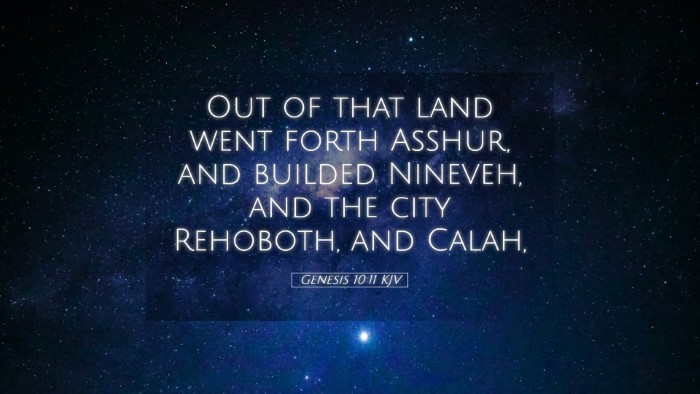Genesis 10:11 - A Commentary
Verse Reference: Genesis 10:11 - "From that land he went into Assyria and built Nineveh, Rehoboth-Ir, Cala, and Resen, which is between Nineveh and Cala; that is, the great city."
Introduction
The genealogies presented in Genesis 10, often referred to as the Table of Nations, provide critical insights into the origins and migrations of various peoples and their geographical locations in antiquity. Genesis 10:11 specifically mentions a significant figure, Nimrod, who played a pivotal role in the establishment of major cities, notably Nineveh. This commentary compiles insights from public domain sources including Matthew Henry, Albert Barnes, and Adam Clarke.
Nimrod the Mighty Hunter
Albert Barnes: Inhis commentary, Barnes emphasizes the significance of Nimrod not merely as a hunter of animals but as a hunter of men. He symbolizes a shift in humanity's ambitions, representing a transition towards civilization and organized society. Barnes points out that his prowess in hunting suggests both his physical strength and the allure of power he held.
Matthew Henry: Henry portrays Nimrod as a figure of authority and rebellion. He suggests that Nimrod established a kingdom outside of God’s will, which reflects a deeper moral decline following the Flood. Henry underscores the importance of Nimrod’s ventures into Assyria, as they foreshadow significant historical developments in this region.
Geographical Significance of Nineveh
Nineveh is highlighted in this verse as a critical city of ancient Mesopotamia, positioned on the Tigris River. It became the capital of the Assyrian Empire, an empire notorious for its military prowess and often brutal conquests.
- Historical Context: According to Adam Clarke, Nineveh’s establishment by Nimrod marks the rise of a significant civilization that thrived for centuries. Clarke points out that the city's later prominence as a center of sin and rebellion against God showcases the cyclical nature of human history.
- Architectural and Cultural Richness: Barnes notes the architectural advancements that came from this era, and how such cities laid the groundwork for advancements in governance and culture.
The Cities of Nimrod
Genesis 10:11 mentions several cities built by Nimrod: Nineveh, Rehoboth-Ir, Cala, and Resen. Each of these locations offers insight into the expansion of civilization during Nimrod's era.
- Rehoboth-Ir: This city's name translates to "broad places" or "streets." Barnes states that this indicates the development of urban spaces designed for community and commerce, reflecting a more sophisticated societal structure.
- Cala: Clarke posits that Cala was likely a significant location due to its strategic position, providing both military and trade advantages to its inhabitants.
- Resen: The mention of Resen as "between Nineveh and Cala" suggests it served as a critical junction between major trade routes, highlighting the importance of connectivity in these early civilizations.
Theological Insights
This verse raises important theological questions regarding the nature of human ambition and the establishment of societal structures apart from God’s design. Here are significant reflections from our public domain sources:
- Human Autonomy vs. Divine Will: Henry emphasizes that the establishment of such cities represents humanity's attempt to build their society independently of divine authority, reflecting mankind’s persistent tendency toward rebellion.
- God’s Sovereignty: Despite Nimrod's endeavors, both Henry and Clarke remind readers that God’s overarching plan remains unthwarted. The rise of empires does not escape God's governance.
- Symbol of Future Judgment: Clarke warns that cities like Nineveh, although great in stature, would eventually become symbols of divine judgment, especially as we consider the later prophetic warnings in scripture.
Conclusion
Genesis 10:11 provides rich historical and theological insights. Nimrod’s legacy, characterized by the founding of significant cities, speaks to both the potential of human ingenuity and the inherent dangers of self-reliance apart from divine guidance. For pastors, theologians, and students of the Bible, this verse serves as a reminder of the complexities of human history, the pursuit of power, and the ultimate sovereignty of God. Understanding these dynamics encourages a reflection on contemporary societal structures and the importance of aligning with God’s purpose for the world.


